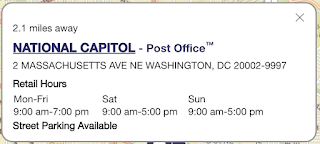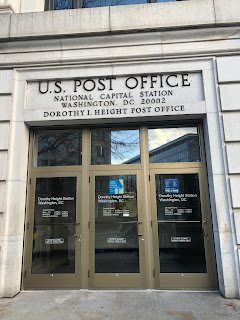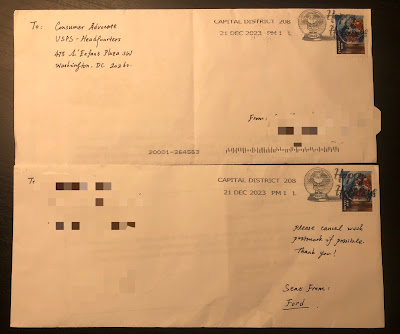*Originally published on another blog of mine, Miscellaneous Notes, now republished here with slight edits and modifications*
FEATURING — National Capitol
First, the Unanswered Question
The more astute readers, at least those more observant than I was, might have noticed in my first blog a slight discrepancy — I keep referring to the first post office I visited as the “National Capitol” station, while in one of the photographs (which I post once more here) it is plainly visible that its entrance reads “National Capital” station. What’s up with that?

it is also one of those rare branches that are open on Sundays
Puzzled, I turned to Google for help. Most of the online resources I found, including those by the mighty USPS itself, seem to call it “Capitol,” and Google even tried to convince me, upon typing in “USPS national capital,” whether I had meant “national capitol” instead. But even the USPS itself isn’t consistent — Its compliance review in 2021 mentions this station as “National Capital,” cited as is in another report by the Congressional Research Service in 2022.

With my digital investigation inconclusive, I did what any sensible person would have done, and wrote a letter to the USPS Consumer Advocate. The letter was sent out in the evening of Dec. 20, by means of me depositing it in my apartment’s mail collection box, and got it back earlier today, on the 23rd. Notice how I say “got it back” and not “received a reply” or “heard back from the Advocate,” because the letter got back to me “as was” — the original letter in its original envelope, unopened, unaltered, with nothing attached. I don’t quite know if the carriers mistook the “from” address for the “to” address, or if the Advocate took one look at the envelope and was immediately repulsed by my handwritten addresses.
I will, of course, re-send this letter to the Advocate’s Office, preferably with some clearer instructions on the envelope. I could always write to the Postmaster General’s Office or his Board of Governors, but I don’t feel comfortable bothering them on so trivial a matter, so the good Advocate will have to endure my curiosity.
Then, the Un-postmarked Envelope
As said, I sent to myself three letters on Dec. 18 (from National Capitol, Union Station and the Dept. of Labor) and two more on Dec. 21 (from Ford and Longworth), so imagine my surprise when the first of these I received (today) was from Ford. Guess the postal system serving Congressional representatives is slightly more efficient, or perhaps it simply doesn’t have too many letters to manage, which, given what I saw, is probably the case.

Anyways, despite me writing “Please cancel with postmark if possible” on the envelope, this plea went unheard. Or, more likely, went heard but was unable to be satisfied because no circular postmark stamps exist anymore at the station. However, both letters (one from Ford and the other for the Advocate) bear this year’s Christmas postmark — a snow globe with Santa Claus in it, marked “2023”. There have been many such holiday postmarks, and many peculiarly named towns (like Santa Claus, IN) that dabble in them, which might deserve a separate entry.
Finally, a Bygone District
The other mark that accompanies our snow globe is a bit more perplexing — it reads on its first line “Capital District 208,” and its second, “21 Dec 2023 PM 1 L.” The first line sounds unproblematic — after all, DC is the capital — but the Capital District as an administrative division within the USPS system doesn’t seem to be a thing any longer. A news article last year refers to it as the “former” District, while a 2021 organizational chart includes no Capital District, but only a Maryland District (under an Atlantic Area) covering Washington, DC. There is, as far as I can tell, a “Capital Metro Operations” office for USPS customer service, but I doubt this office had anything to do with postmarking. More interestingly, under the current system “208” doesn’t even seem to be the first-three-digit-zip-code for DC — it should have been “200” — but that for a part of Maryland. My only theory is that this administrative change has yet to be reflected in new equipment and procedures.
The second line is more illuminated. The date is obviously that of the day letters were sent out, while the “L,” according to a Redditor, standing for the stamp “leading” an envelope, i.e., identifying which side the mailpiece was facing while being processed. Some older mail bears the alternative “T” for “trailing,” but due to the phasing out of certain old equipment, “T”s are becoming rarer and rarer. “PM1” refers to a specific machine at the particular processing facility (or perhaps station?), mostly likely a Siemens AFCS2000, the functioning of which can be seen in a video here.
